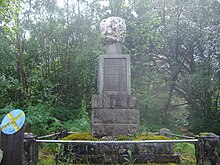Colin Roy Campbell
| Appin Murder | |||||||
|---|---|---|---|---|---|---|---|
| Part of the aftermath of the Jacobite Rising of 1745 | |||||||
 Memorial to James Stewart of the Glen who was wrongly convicted and executed for the Appin murder |
|||||||
|
|||||||
| Belligerents | |||||||
|
|
|
||||||
| Commanders and leaders | |||||||
|
|
James Stewart of the Glen |
||||||
| Casualties and losses | |||||||
| Colin Roy Campbell of Glenure killed | James Stewart executed Allan Stewart exiled |
||||||
Coordinates: 54°53′42″N 2°56′02″W / 54.895°N 2.934°W
The Appin Murder occurred on 14 May 1752 near Appin in the west of Scotland, and it resulted in what is often held to be a notorious miscarriage of justice. It occurred in the tumultuous aftermath of the Jacobite Rising of 1745.
The murder inspired events in Robert Louis Stevenson's novel Kidnapped.
On 14 May 1752, Colin Roy Campbell of Glenure, 44, the government-appointed Factor to the forfeited estates of the Clan Stewart of Appin in North Argyll, Scotland, was shot in the back by a marksman in the wood of Lettermore near Duror. The search for the killer targeted the local Clan, the Jacobite Stewarts of Appin, who had recently suffered evictions on Campbell's orders.
The chief suspect, Allan Stewart (or Alan Breck Stewart) having fled, James Stewart (also known as Seumas a' Ghlinne [James of the Glen] and brother of Ardsheil), one of the last leaders of Stewarts, was arrested for the crime and tried for the murder. Although it was clear at the trial that James was not directly involved in the assassination (he had a solid alibi), he was found guilty "in airts and pairts" (as an accessory; an aider and abetter) by a jury consisting of people from the locality where the crime occurred. The presiding judge was pro-Hanoverian Archibald Campbell, 3rd Duke of Argyll, Chief of Clan Campbell; 11 Campbell clansmen were on the 15-man jury.
...
Wikipedia
